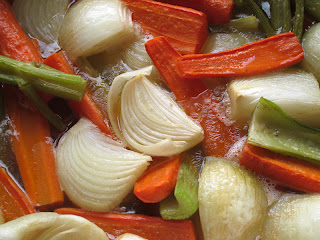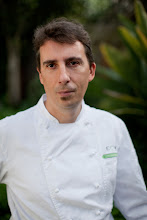Stocks have so many uses in the fall and winter, that I make sure I always have some on hand.
Here I've made two very similar, yet very different chicken stocks. The first a basic stock with good flavor and rich in gelatin. Then a second one made from the first stock using roasted bones. In the restaurant I referred to this second stock as double dark chicken, or 'dbl dk chix'.
Rather than list a recipe with specific amounts, a quick understanding of proportions will get you on your way. The starting point should be your stockpot...get twice as many bones as will fill that stockpot about 3/4 full...
Here I've made two very similar, yet very different chicken stocks. The first a basic stock with good flavor and rich in gelatin. Then a second one made from the first stock using roasted bones. In the restaurant I referred to this second stock as double dark chicken, or 'dbl dk chix'.
Rather than list a recipe with specific amounts, a quick understanding of proportions will get you on your way. The starting point should be your stockpot...get twice as many bones as will fill that stockpot about 3/4 full...
Now for the aromatic vegetables that will flavor the stock. Unlike baking, no exact measurements are needed here. The total amount of the vegetables should be about 1/3 the volume of the bones. A good rule of thumb for the mix is about 50% onions, 25% carrots and 25% celery. If I happen to have some fresh fennel around or some parsley stems, I’ll throw those in as well.
The size that you cut the vegetables does matter and here is why. You want them to release all of their flavor into the stock, but you don’t want them to cook so long they fall apart, clouding the stock. So the longer a stock will simmer, the larger you will want to keep the vegetables. For the chicken stock, I cut onions in quarters, and the carrots and celery in about 4 inch lengths.
For the first stock...
Pour enough cold water over the bones in the stockpot to just cover and slowly bring to a simmer...adjust the heat so it never boils...just bubbles occasionally. Logic would dictate that starting with hot water would give you a head start on the cooking, but it will result in a cloudy result, so avoid the temptation.
Pour enough cold water over the bones in the stockpot to just cover and slowly bring to a simmer...adjust the heat so it never boils...just bubbles occasionally. Logic would dictate that starting with hot water would give you a head start on the cooking, but it will result in a cloudy result, so avoid the temptation.
As it slowly comes to a simmer, both fat and foam will rise to the surface. Skim this away as it collects. Simmer the bones for about 45 minutes to an hour (continuing to clean the surface) then add the vegetables. Continue to simmer until the bones fall apart easily. Chicken stock only needs to cook about 2-3 hours, after that you are simply cooking away those fresh flavors. Strain the stock through a fine mesh strainer and discard all of the bones and vegetables. Let the stock sit a few minutes, then skim off any remaining fat. Cool the stock quickly and store in the refrigerator, or go directly to making the second stock.
For the second stock...
Roast the second half of the bones in the oven until they are very well browned, making sure not to let any pieces get too dark. Once browned, remove them from the oven. If any of the bones happen to get to dark, just remove those portions. Just a small piece of bone blackened in the oven can impart its bitterness on your entire batch of stock. After adding the bones to the pot, pour off any excess fat from the roasting pan, then scrape all of the crusty brown bits from the bottom into the stock pot. These bits are culinary gold and your stock will suffer without them...don’t let them get away. Alternatively, you can put the pan on a medium flame, add some of the stock and simmer slowly to dissolve the bits stuck to the bottom. Add all of this to the stockpot with the bones and the 1st stock you made. Give this one about a 1/2 hour head start, then add the vegetables and cook for another hour to hour and a half. There will be much less cleaning to do as this stock cooks, but it should be tended to, nonetheless.
Again, strain the stock, skim any remaining fat and cool and store as quickly as possible.
Now take advantage of the fact that you have some great stock(s) at your disposal. Make some soup, or better yet...braise something!
Again, strain the stock, skim any remaining fat and cool and store as quickly as possible.
Now take advantage of the fact that you have some great stock(s) at your disposal. Make some soup, or better yet...braise something!

















































